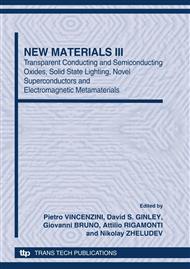[1]
A. Daniels, Fisicoquímica. CECSA. (1982).
Google Scholar
[2]
A. Dassler. Electroquímica y sus fundamentos electroquímicos. UTEHA, 1962. Part I: pp.121-141; Part II: pp.92-174.
Google Scholar
[3]
D. Ball. Physical Chemistry. 1st Edition. Cengage Learning Publisher, 2004. ISBN 9706863281.
Google Scholar
[4]
B. O'Regan, M. Graetzel. Nature. 353 (24), 737-740. October (1991).
Google Scholar
[5]
M. Bär, K. -S. Ahn, S. Shet, Y. Yan, L. Weinhardt, O. Fuchs, M. Blum,S. Pookpanratana, K. George, W. Yang, J. D. Denlinger, M. Al-Jassim, and C. Heske1: Applied Physics Letters 94, 012110 (2009).
DOI: 10.1063/1.3056638
Google Scholar
[6]
V. Capozzi, G. Perna, P. Carmone, A. Gallone, M. Lastella, E. Mezzenga, G. Quartucci, M. Ambrico, V. Augelli, P.F. Biagi, T. Ligonzo, A. Minafra, L. Schiavulli, M. Pallara, R. Cicero. Thin Solid Films 511-512 (2006) 362-366.
DOI: 10.1016/j.tsf.2005.12.065
Google Scholar
[7]
Y. T. Thathachari, M. S. Blois. Biophysical Journal, Vol. 9, Issue 1, 77-89, 1 January (1969).
Google Scholar
[8]
T. Sarna, P. M. Plonka. Biomedical EPR, Part A: Free Radicals, Metals, Medicine, and Physiology. Spronger US Publisher. ISBN 978-0-306-48506-0. pp.125-146.
DOI: 10.1007/0-387-26741-7_7
Google Scholar
[9]
C. C. Felix, R. C. Sealy. J. Amer. Chem. Soc. 100 (1978a) pp.3922-3926.
Google Scholar
[10]
C. C. Felix, J. S. Hyde, T. Sarna, R. C. Sealy. J. Amer. Chem. Soc. 103 (1981) pp.2831-2836.
Google Scholar
[11]
A. Solís, M. E. Lara, L. E. Rendón. Nature Precedings. Posted 12 November 2007. http: /precedings. nature. com/account/show/1105.
Google Scholar
[12]
D. C. Altamirano-Juarez. Advances in Science and Technology. Trans Tech Publications Ltd. (54) 2008. pp.337-342.
Google Scholar
[13]
D. C. Altamirano-Juarez. Influencia de la variación de parámetros involucrados en la técnica Sol-Gel, en películas delgadas de ZnO impurificadas, para su uso como electrodos transparentes. Doctoral Tesis. (Library of CINVESTAV-IPN, Unidad Querétaro; México. Agosto 2007).
DOI: 10.24275/uami.dj52w4823
Google Scholar
[14]
D. C. Altamirano-Juarez, R. Castanedo-Perez, O. Jimenez-Sandoval, S. Jimenez-Sandoval, J. Marquez-Marin and G. Torres-Delgado. Modern Physics Letter B. Vol 15, 17-19 (2001) 730-732. Word Scientific Publishing Company.
DOI: 10.1142/s0217984901002403
Google Scholar
[15]
S. A. Studenikin, Nickolay Golego and Michael Cocivera. J. Appl. Phys. Vol. 87 (5) (2000) pp.2413-2421.
Google Scholar
[16]
C. A. Bishop, L. K. J. Iong. Tetrahedron letters 41, 3043 (1964).
Google Scholar


